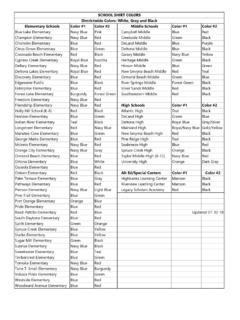Transcription of Fully Beaded Valise With Pictographic Designs by Nellie ...
1 Fully Beaded Valise with Pictographic Designs by Nellie Two Bear GatesLakota/YanktonaiCirca 1907 Collection: WarnockItem Number: WC9206020 Category: Bag - Beaded ValiseRegion: PlainsTribe: Sioux - Northern TetonPeriod: 1900-1925 - ca. 1907 Materials: Multi-colored glass seed beads; commercially tanned leather traveling case;brass and iron : Traveling case is Fully bead decorated with Pictographic Designs . On oneside an equestrian warrior wearing a trailer bonnet and holding a rifle faces anothermounted warrior who is holding a tomahawk.
2 The words Nellie Gates 54 yrs. to J. 1907 appear in beadwork. Two mounted warriors holding crooked lancesappear on opposite : Length 18 inchesProvenance:Made by Nellie Gates, Standing Rock SiouxGiven to J. A. Archambault in 1907 as a wedding presentDescended to Pat Archambault (grandson of Nellie Gates), OregonEpic Fine Arts :Smithsonian Institution, Washington DC, 1937 -1939 Splendid Heritage, Wheelwright Museum of the American Indian, Santa Fe, May 27,1995 - September 27, 1995 Eiteljorg Museum, Indianapolis, October 23, 1998 - October 3, 1999 References:2 Lessard, F.
3 Dennis, Pictographic Art in Beadwork from the Cheyenne River Sioux,Volume 16, Number 1, Winter 1990, American Indian Art Magazine, Vol. 16, No. 1(Winter 1990), Fig. 11 Important American Indian Art, Sotheby's Auction Catalogue Sale 6297, June 12, 1992(New York: Sotheby s, 1992), Lot 147 Penny, David W., Native American Art Masterpieces (Detroit: Hugh Lauter LevinAssociates, 1996), 46-47 Berlo, Janet C and Ruth B. Phillips, Native North American Art, (Oxford: OxfordUniversity Press, 1998), 31, Fig 20 Prior to the reservation period of the late-19th century and for some time extending intothat transformative era culturally mandated boundaries existed among Plains Indians whichdelineated the use of representational and geometric forms of artistic expression.
4 Theseboundaries remained remained fairly well fixed along the same lines that existed in the days ofthe pre-reservation buffalo culture. Basically, the use of these two forms representational andgeometic was largely gender a rule, women painted, quilled, and Beaded geometric Designs onto such objects asparfleches, clothing, and pipe bags. The realm of representational forms, such as the drawings ofcombat deeds painted on buffalo robes, tipis, and paper pages obtained from whites through tradeor capture fell into the purview of were, to be sure, exceptions to this general rule.
5 For example, men paintedgeometric Designs on the surfaces and buckskin covers of their buffalo hide war shields. Inaddition, women occasionally quilled and Beaded Pictographic imagery onto some of the objectsthey made, such as pouches, although it seems likely that prior to the reservation era theseimages followed patterns that may initially have been sketched on the surface by the northern Great Plains round the end of the 19th century a few Lakota (TetonSioux) women began creating extensively Beaded Pictographic images on a diverse array of3surfaces.
6 Those surfaces included many previously non-traditional items such as vests,gauntlets, and the object examined here, a Valise . Although reflections of this practice are seenin the work of a few anonymous women among the Lakota tribes1 the best documented examplesof them as representatives of an oeuvre of work come from two or more women living onStanding Rock Reservation and possibly Cheyenne River Reservation as showing location of Indian tribes in South Dakota and southern North Rock Reservation is the area outlined at the top of the map west of theMissouri River.
7 Including the communities of McLaughlin and River Resrvation is immediately south of Standign rock andincludes thecommunity of Eagle : South Dakota Department of Tribal RelationsBack in 1990 and 1991 F. Dennis Lessard, in a pair of articles published in AmericanIndian Art Magazine, made a stab at pinning down the point of origin for these works, using, asone example, the Beaded Valise discussed initially believed that while all seven Lakota tribes produced beadedpictographic scenes, mostly horses and riders or standing figures during the late-1800s and early41900s, the beadwork technique is different and the overall effect is quite different from theCheyenne River style.
8 The name he applied to the works he that point, Lessard was convinced this Valise and the other pieces he highlightedexemplified a rare style of beadwork he saw as a unique expression of Miniconjou art from theCheyenne River Indian Reservation. 4 Upon reflection, however, Lessard set thischaracterization aside and apparently based to a significant degree on the photograph below ofJoe Claymore and his wife Edith of Standing Rock Reservation, an image evidently taken around1900 averred that he believed this work should be described as the Edith Claymore style.
9 5 Joe Claymore (Clement) and his wife Edith show in a photogrpah takenby Frank Fiske, probably around 1900. Bags arranged in a pyramidseparate the couple. The one shown at the lower left of this arrangementdisplays an eargle, flags, stars, and a cameo commemoratinhAdmiralGeorge Dewey s accomplishments in the Spanish-American War of1898, thus establishing a date before which the photograph could nothave been : State Historical Society of North Dakota5 Lessard made it clear he worked on the assumption that Edith Claymore, the woman inthe photograph, was the creator of all of the items we see in the photograph, although he wasalso aware that this assumption could be wrong.
10 6 Insofar as I am aware Lessard never revisited this topic in print, which is unfortunatebecause evidence not available to him at the time he wrote about the subject has since becomeavailable. This evidence in no way negates his accomplishment in pulling together informationor the enthusiasm he displayed in attempting to present as full a picture as possible. Evidencenot available to him, however, indicates at least two of the eleven Beaded tipi bags, pipe bags,and valises he relied on when laying out his case, all of them objects he evidently believed to bethe product of Edith Claymore s labors, were in fact made by someone else: Nellie Two Two Bear Gates, photographed by Frank Fiske in the early 1900s,around the time she made the Valise discussed.





